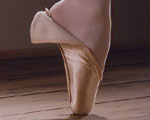Jean-Claude Dupont
The Meaning of Objects

Insisting on the functional
context of objects, Dupont examines the primary and secondary functions
(both utilitarian and magical) of objects. He proposes that objects can
be classified according to “families” and “systems"
and that by organizing objects in this way one can reveal and examine
their functional value. A family of objects denotes a group of things
that have similar design elements but which may be used to different ends.
By noting the distinct uses to which these similar objects are put, objects
can then be placed within a “system” or appropriate milieu
based on their distinct function.
While I attempted to classify “pointe shoes” within the greater
“family” of shoes, according to the model put forth by Dupont,
this group of objects has confounded these efforts. Articulation of difference
between these objects based on function is complicated due to a number
of reasons. Many differences seem to be based on value judgments and would
therefore lack objectivity and the ability to be applied cross-culturally.
For example, to split the family of shoes into categories of “formal”
and “casual” is unhelpful in that notions of formal and informal
are subjective and apt to change depending on the wearer.
If it can be assumed that all shoes function as protection for the feet,
the level of protection varies in degree and in kind. In some cases, the
design of a shoe is paradoxical in terms of its protective value and it
harms the foot while purporting to protect it (pointe shoes seem to fall
into this category). As well, breaking shoes down into component parts
(toe, heel, sole, etc.) is also unhelpful due to the fact that the various
elements that make up these parts confound isolation into useful categorization.
For example, shoes with low heels aren’t exclusively square toed
with laces. Every toe shape exists for virtually every heel elevation.
By the time all the design elements have been taken into consideration,
all useful categorization has been lost. I haven’t given up hope
that this model may still prove to be useful. I have made efforts to contact
the curator, Elizabeth Semmelhack, at the Bata Shoe Museum to see what
classification system is employed to keep track of their collection. I
hope to discuss this with someone in the New Year.
However, while Dupont’s model for classification is not entirely
successful when applied to pointe shoes, his notion of secondary functions
is somewhat more illuminating and gave rise to a number of questions.
Why are shoes, in this case, ‘pointe shoes,’ designed with
the paradoxical function to protect/aid and to hurt/harm? Does this indicate
that the design fulfills a non-utilitarian purpose? While the ribbons,
blocked and stiffened toes, and leather shanks are all intended to allow
the dancer to rise to and stay on the points of her toes, they don’t
make this act effortless or painless (a fact made evident by the profusion
of products which claim to numb toes, ease pain, and build calluses for
dancers). As well, Dupont’s proposal of secondary functions, especially
in terms of magical functions, may be illuminating. Hans Christian Anderson’s
story, The Red Shoes (1845), tells the tale of a girl named Karen,
who’s fixation on her red shoes leads to her being cursed to dance
uncontrollably and ultimately, to the amputation of her feet. While not
pointe shoes, the use of red dancing shoes within this moralizing tale
may indicate the presence of some myth that was circulating at that time
(mid-nineteenth century). The story seems to conflate dancing with vanity
and lack of control and all of these hinge on Karen’s shoes. Perhaps
further examination along these lines would be illuminating.